READING TIME, 7 MINUTES
Hello, fellow digital enthusiast!
If you’re anything like me, your electronics are as important to your travels as, say, your passport or your travel snacks.
Are you with me? If the answer is yes, that means you want to pack your electronics for travel so they make it safely to your destination.
However, traveling with tech toys can sometimes be more challenging than you initially think.
With different devices, chargers, and accessories to think about, ensuring all your electronics and gadgets are safely and efficiently packed is essential.
How to Pack Your Electronics
How to Pack Your Electronics
The following will help you confidently pack your electronics for travel and protect them safely while you're away from home.
How to Pack Photographic Equipment: Capture Every Moment (Without Any Mishaps)
Protection first
Start with padded cases and sleeves or protective cases for your camera and lenses. You want to prevent damage from bumps or drops. B&H Photo has a great selection, and they have excellent service. Just have a pocket-sized camera or a small lens? Try wrapping it with bubble pack.
If you use your phone for photography (we mobile photographers know it’s really a camera that you can talk on📱), then get a leash. I often use a cross-body Bandolier as I love the pouch on the back that holds a credit card, my ID, and a bit of cash.
Having your phone on a leash makes it easy to get through airport security (no fishing it out of a bag, you don't leave it in the seatback pocket of the plane or train, and you don't need to worry about some evil person ripping it out of your hands and making off with it.
There are definitely less expensive phone leashes and straps you can find online, but I haven’t been willing to trust my $1,000+ camera/phone to them, so I don’t feel comfortable recommending them. If you’ve found a phone holder with a neck strap or a wrist strap that you trust, please let us all know in the comments below.
Get a dedicated bag
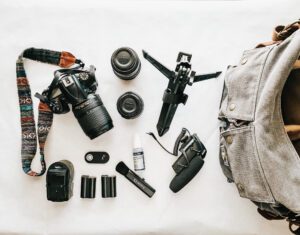
Photo by Derick McKinney on Unsplash
A specialized camera bag with individual compartments is recommended if you’re carrying multiple lenses and camera bodies. You’ll want to bring this on the plane unless you have a specialized, hard-sided trunk for shipping. Checked baggage can sometimes be handled roughly, risking damage to your camera gear. So to be safe, your camera bag must replace either your carry-on luggage or your personal item.
If you’re taking a digital camera with a couple of lenses, you are probably a pro at this and already have your favorite bag. Unless your town still has a camera shop where you can look at various bags (lucky you), B&H Photo is your place to shop online.
If you’re using either a pocket camera or a smartphone, there are a lot of small bags and pouches to choose from. Check out Moment. The Long Weekend Santa Fe Shoulder Bag has room for your pocket camera, your phone, a small Joby Gorillapod, a bottle of water, keys, and maybe a snack. There’s even a pocket for memory cards or external lenses. And it’s waterproof! You could pack most of your small to mid-size tech items in this bag and keep them all corralled together in your carry-on.
Bring spare portable batteries
How many times have you set off for a day of photography only to realize that your battery is dead? Bring spare batteries and always leave one charging in your hotel room.
And if you're traveling by air, you'll need to keep your spare camera batteries and/or your portable power bank in your carry-on.
You’ve probably heard horror stories about electronic devices with lithium-ion batteries catching on fire on airplanes. (We’re talking about you, Samsung phones!) Airline crews are trained to deal with these types of fires. But imagine if these fires started in checked luggage! Not good.
So please heed the Federal Administration (FAA) guidelines below about which types of batteries you can put in your checked luggage and which must be brought with you in the cabin. According to the FAA:
"Spare (uninstalled) lithium ion and lithium metal batteries, including power banks and cell phone battery charging cases, must be carried in carry-on baggage only.
When a carry-on bag is checked at the gate or at the planeside, all spare lithium batteries and power banks must be removed from the bag and kept with the passenger in the aircraft cabin. The battery terminals must be protected from short circuit."
You don’t want to be held up in security by having too many of the wrong types of batteries in your carry-on, and you definitely don’t want to be the person starting a fire with your checked bag in the cargo bay. So, if you have any questions at all, please read the entire FAA guidelines here. Prefer the picture version? Scroll down to page 2 here.
If you're traveling with batteries in other devices like battery-powered wheelchairs or gaming consoles, check the full list of what is allowed and what isn't that's published by the Transportation Security Administration.
And just to be on the safe side, if you’re traveling internationally, it’s a good idea to see if there are any local guidelines that differ from those of the FAA.
How to Pack a Laptop or Tablet: Your Portable Office and Entertainment Device
Talk about packing electronics for travel! Your laptop may be one of the most valuable pieces of tech gear you'll be traveling with, so protecting it on its journey is essential.
Secure with sleeves
Put your laptop or tablet in a padded sleeve to protect it against bumps. Be sure to choose one that fits your device correctly.
Backup your files
Back up all your important files before you go. And then back up at the end of each day, either to the cloud or to a portable hard drive. You don’t want to lose all those gorgeous vacation photos!
Expert advice
If you haven’t updated your password in a while, now’s the time to do so. (You’re not still using “password” or “12345,” are you? Please say no!)
You’re more likely to pick up malware while traveling and logging in to public WiFi as you go than you are at home.
If you’re using a password manager, you might consider changing the master log-in before you leave and again when you return home. Better safe than sorry.
How to Pack Chargers, Cables, Power Banks: Your Lifelines
 Stay organized
Stay organized
Use a dedicated electronics organizer, simple zip-lock bags, or a rubber band to keep USB cables, power cables, and chargers organized. If you only have a few cables, you can even keep them organized in an old glasses case.
I love my Tom Bihn Size 1 Handy Little Thing organizer bag. It corrals my cables and has room for chargers and miscellaneous small items. Another good choice is one of the Tech Kits from Bellroy.
Expert advice
As of early 2024, most hotel rooms haven't updated their USB ports from USB-A to USB-C, so be sure to bring along some A-to-C connectors.
Label your cables
Have you ever tried to figure out which cable belongs to which device? No problem if you're just charging your phone. But if you're more along the lines of a digital nomad, it can take a while to figure out what goes with what.
One of the best ways to avoid this annoyance is to label your cables. You can thank me later!
Power banks
Whether you call it a power bank or a portable charger, you need to know that, with air travel, back-up batteries are carry-on only as per FAA regulations. Just remember, they’re too “powerful” for the checked luggage. So if you have to gate-check your bag at the last moment, remember to pull these items out and take them with you in the cabin—just another reason to have all your small tech gear well organized in its own little bag.
Take a photo
Once you have all your things organized, take a photo. The items most frequently left behind in hotel rooms are cables and chargers. If you have a photo of what you brought, you can do a quick inventory before you leave your room to be sure you have everything repacked.
How to Pack Adapters: Because Not All Outlets are Created Equal
Know before you go
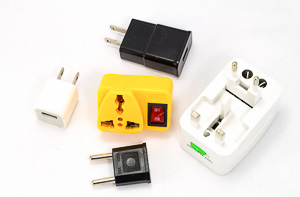 Research the kind of adapter you’ll need for your destination(s) and make sure you have an adapter before you go. A US plug won’t be making friends with a UK socket without a bit of help.
Research the kind of adapter you’ll need for your destination(s) and make sure you have an adapter before you go. A US plug won’t be making friends with a UK socket without a bit of help.
Get a universal adapter
I used to wait until I was at a destination and then pick up an adapter or borrow one from a hotel. However, depending on where you're traveling to, that may not work. Indonesia comes to mind from a recent trip where the local stores were out of what I needed and I could only borrow an adapter from the hotel for a few hours at a time.
A universal travel adapter will be your new best friend if you’re a frequent traveler. This travel adapter works for the USA, the European Union, the United Kingdom, and Australia. If you’re going elsewhere, look online for the country you’ll be visiting or visit a travel store if you have one nearby.
See if you need a voltage converter
Check the voltage requirements of each of your electronic devices against the voltage requirements of the countries you’ll be visiting. For example, electronics and appliances made in the US run on 110 volts. In Europe, they're 220 volts. If you plug your 110-volt device into a 220 socket, you're likely to blow it up. Your first hint will be that you smell something burning, and then, guess what? Your device won't work. Ever again. 😵
Hopefully, if you look at the tag on the back or side of your device or on the power cord, it will say 110-220 volts. In that case, you'll be good to go. If not, leave the device at home or bring a voltage converter.
How to Pack Other Small Items: The Little Heroes
Earphones and AirPods
Those little earbuds are more delicate than they seem, so invest in a hard case. And for peace of mind (and to avoid them going walkabout), train yourself always to put them back in the same place each time you use them.
SD cards
Use small cases or organizers to prevent loss. Because a lost SD card is a memory forgotten. So sad 🥲 (she says from experience!).
Bluetooth speakers
You're allowed to bring a Bluetooth speaker in your carry-on bag as long as the battery power doesn't exceed 100 watt-hours. Just be sure your speaker is well cushioned in your bag so it makes it to your destination safely.
Navigating Airport Security: Patience!
One of the reasons for packing your electronics for travel properly is so you can find them when you need them. The other reason is to help you sail through the security checkpoint if you're traveling by air.
Get organized
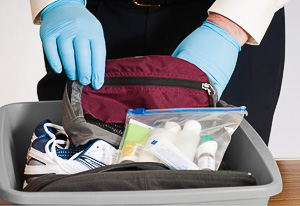 You don’t want to miss your plane, and electronic devices are one of the most frequent items that hold up the security line (food being the other). So it will be easier and quicker if you put your electronics in one, easy-to-access place rather than scatter them throughout your luggage.
You don’t want to miss your plane, and electronic devices are one of the most frequent items that hold up the security line (food being the other). So it will be easier and quicker if you put your electronics in one, easy-to-access place rather than scatter them throughout your luggage.
-
- Be ready. Laptops, tablets, cameras, and other electronic items may need to come out of their cases and go into separate bins. Even if you're using TSA PreCheck, you may be required to take your devices out. You never know, so be prepared. Know where everything is and pack it so it’s easily retrieved.
- Use organizers. Group related items, such as chargers with their corresponding cables, and put camera accessories in one place so they’re easy to find if the security officer has questions.
- Stay calm. If an officer asks you about a device during a security check, simply explain what it is. Saying, “This is my noise-canceling headphone to drown out airplane noises,” is better than a dramatic sigh and an eye roll.
Expert advice
When going through security, put your devices on the belt right before your shoes. You might wander off before you pick up your laptop or camera bag, but you’re not likely to go off without your shoes. I left my laptop in the security line at JFK Airport in New York after a long international flight. It never got returned, so I learned the hard way.
Track Your Expensive Electronics: Keep the Tech Gear Together
No point packing your electronics up nicely if they go missing. So before you leave, turn on (and be sure you know how to use) device trackers. Look at Find My for your Apple devices or Find My Device for Android users.
Also, put a luggage tracker like an Apple AirTag or Tile in each of your bags. These are Bluetooth devices, so you’ll need to sync them with your phone beforehand. Instructions on how to do this will come with the trackers.
Check Your Airline Weight Limits: Do You Need a Digital Diet?
Depending on what you intend to bring along on your trip, your electronics might take up most of your weight allowance for your carry-on luggage, especially if you're planning long-term travel.
So, if you're flying, look up your airline's luggage weight requirements and weigh your checked and carry-on luggage before heading to the airport.
You may need to eliminate some items, downsize to a smaller version, get a hard case and pack electronics as checked luggage, or cushion your electronics between layers of clothes in your checked bag and hope for the best.
Travel insurance, anyone? Maybe not a bad idea.
Final Thoughts on How to Pack Your Electronics for Travel
Packing your electronics for travel is both an art and a science. The science includes the proper precautions and organization so your gadgets will be well-protected, you’ll be stress-free, and you can sail through security without a hitch.
The art comes with learning to travel with fewer electronics and tech gadgets and organizing them so that they're accessible in an instant.
Remember, it’s not just about keeping these valuable items safe; it’s about ensuring they’re ready to capture memories, entertain, and keep you connected.
So, bon voyage and safe travels to both you and your devices! 👋🌎🛳️
P.S. Have any electronic tips to share? Please post them in the comments below so we can all learn from your experience.
Pin this post to read later
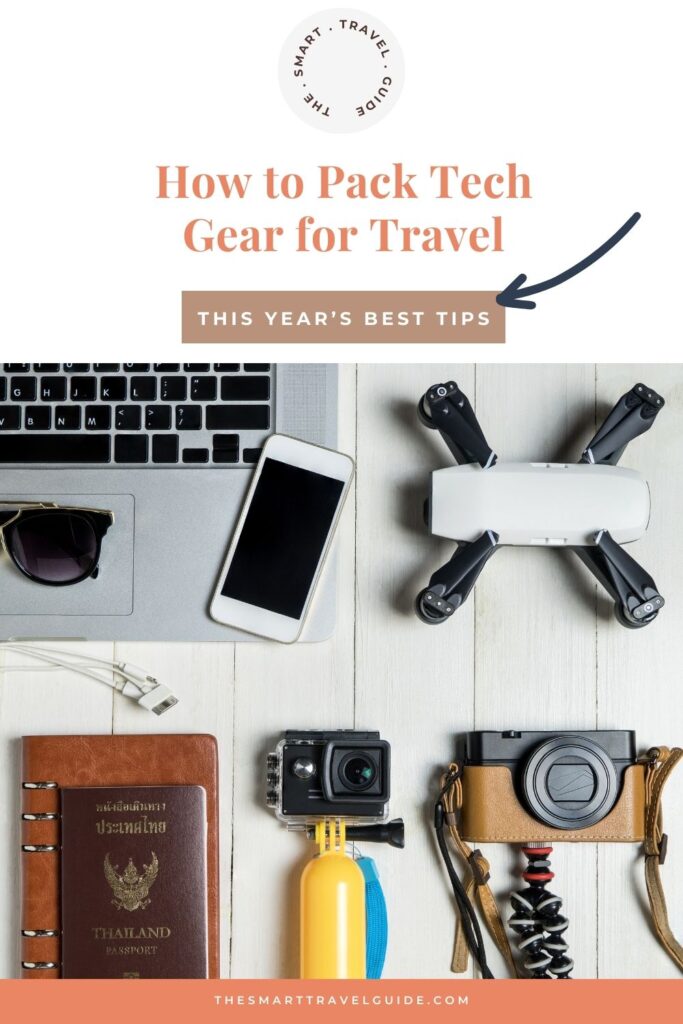
- About the Author
- Latest Posts
Peggy is a retired entrepreneur and world traveler, now happily traveling in the second half of life. She’s flown over 2 million miles and spent time in 48 states and 50+ countries, much of this since she turned 50. Read the About page to learn more about Peggy and why she started The Smart Travel Guide 10 years after retiring. If you want to send Peggy a brief message, visit her contact page.
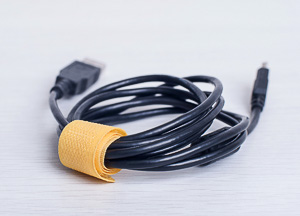 Stay organized
Stay organized
Be the first to comment